Spring is here! What’s the garden-chores checklist for April?

The days are getting longer, the sunlight is a bit warmer, and even though we lost an hour of sleep when we sprang ahead, April means one thing to gardeners — the first full month of spring! So dig out your soil thermometer and grab your favorite garden gloves, it’s time to get to it!
- Map out your vegetable garden — Head out into your yard with a pad and paper and plan your vegetable garden for spring, summer and fall. Which vegetables do you want to grow? When do you plant them and when will they be ready for harvest? Which spots in your yard get full sun and which spots get partial shade? Serious planning now can give you a bountiful harvest for much of the year ahead.
- Take your soil temperature — In early spring, the key to knowing when to plant is knowing the temperature of the soil in your garden area. Springtime weather in southern Oregon is still fairly cool, so having a good read on the soil temperature is a big help. Once the soil is consistently at or above 40° Fahrenheit, you can begin planting cool season crops, such as kale, lettuce, onions and spinach.
- Spread compost — March is a great time to spread compost over your garden and landscape areas. Not sure which one to purchase? Not to worry, we’ve got you covered! Rogue Compost is made from leaves, grass clippings and plant matter collected right here in the Rogue Valley. You can buy it in bulk (delivered to your door or for pick-up at the Transfer Station) or in bags.
- Fertilize your evergreen shrubs and trees — It’s been a long winter! Check out any evergreen shrubs and trees on your property and if they look like they could use a hand, consider fertilizing them. If they are well-established and look healthy, their nutrient needs should be minimal.
- Fertilize your other shrubs too — This is also the time to fertilize three Northwest favorites — azaleas, camellias and rhododendrons, using an acid-type fertilizer. Just like the evergreens, if they are well-established and look healthy, their nutrient needs should be minimal.
- Divide daylilies, hostas and mums — If you have these flowering plants in your yard, this is a good time to divide them into sections to make new plants.
- Perform rose maintenance — Roses don’t love all the moisture that typically comes from winter and early spring. To control rose diseases, such as black spot, remove any infected leaves and spray as necessary with a fungicide specially designed to tackle black spot.
- Watch for slugs — To protect your new plant growth from slugs, start with the least toxic pest management options, such as barriers and traps. Baits are also available for slug control, just remember to use caution around pets.
- Select plants that bring in beneficial insects — There are a rainbow of plants that attract beneficial insects to your yard, helping keep plant-ruining predatory bugs at bay. If soil temperatures allow, plant varieties such as alyssum, candytuft, coriander, creeping thyme, dara, dill, echinacea, fennel, mint, phacelia, sunflower and yarrow to deter pesky pests.
- Dig in with berries — Want ripe, delicious berries this summer and fall? Now’s your chance to plant the full array of berry crops that do well in our part of the country — including blueberries, blackberries, currants, gooseberries, raspberries and, of course, strawberries.
Share This
